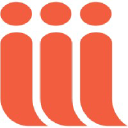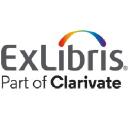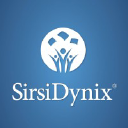Top Library Management Systems 2024
1. Polaris ILS
- Streamlined circulation and cataloging processes
- Responsive web client for remote staff operations
- Integration with e-content for enhanced patron experience
- Robust reporting capabilities with SimplyReports

Polaris ILS offers a streamlined circulation and cataloging experience, with a responsive web client for remote staff operations. It integrates seamlessly with e-content and provides robust reporting capabilities through SimplyReports, ensuring an efficient and user-friendly library management solution.
Optimize your library operations with Polaris ILS, designed to enhance patron services while reducing overhead and improving staff workflows.
2. Follett Destiny Library Manager
- Efficient asset tracking and management
- Cloud functionality for easy access and data management
- User-friendly interface and intuitive menus

Follett Destiny Library Manager offers efficient asset tracking and management, seamless cloud functionality, and a user-friendly interface. The tool is designed to streamline asset management processes and improve overall efficiency.
Experience the ease of data access and management with Follett Destiny Library Manager.
3. Sierra ILS
- Unified Application: Manage all library workflows within one interface, saving time and streamlining operations.
- RESTful APIs: Access data in your Sierra system for patron self-service functions and third-party solutions, enhancing connectivity and accessibility.
- Sierra on the Go: Access Sierra functions from a web interface on any device, including mobile worklists for staff and a mobile patron application for iOS and Android.

Sierra ILS is a comprehensive library services platform that offers a unified application for managing all library workflows, RESTful APIs for enhanced connectivity, and mobile access with Sierra on the Go.
With features including cataloging, acquisitions, circulation, and eResource management, Sierra ILS provides a seamless and secure solution for modern library operations.
4. Springshare
- Comprehensive suite of tools for content creation, resource curation, and knowledge sharing
- 24/7 virtual reference service through the world's largest librarian co-op
- Proven track record of helping libraries modernize and thrive in a digital-first world

Springshare offers a comprehensive suite of tools designed to help libraries, educational institutions, and non-profits excel in the digital age. With a focus on content creation, resource curation, and knowledge sharing, Springshare is the go-to platform for organizations looking to modernize their library services.
By embracing Springshare, libraries gain access to a 24/7 virtual reference service, affordable and easy-to-use SaaS platform, and a commitment to their success through outstanding customer support and active user community.
5. Apollo ILS (Integrated Library System)
- User-friendly interface for efficient library management
- Empowers patrons with state-of-the-art catalog and access to third-party e-resources
- Streamlined circulation management with text, email, and phone notifications
- Smooth and automatic migration process with minimal disruption to library patrons

Apollo ILS (Integrated Library System) is a user-friendly and efficient solution designed exclusively for public libraries. With streamlined circulation management, state-of-the-art catalog features, and an easy migration process, Apollo ILS empowers libraries to provide exceptional service to their patrons.
This innovative technology enhances the efficiency of library operations and delivers a seamless user experience, making it a valuable asset for public libraries looking to modernize their management processes.
6. Ex Libris Alma
- Unified platform for managing print, electronic, and digital materials
- Completely cloud-based, cost-effective solution
- User-friendly interface for streamlined library management

Ex Libris Alma is a unified library services platform for managing print, electronic, and digital materials, offering a completely cloud-based and cost-effective solution for modern libraries.
With a user-friendly interface and comprehensive features, it streamlines library workflows and enhances user experience, making it a top choice for libraries of all sizes.
7. SirsiDynix Symphony
- Robust and proven ILS for various types of libraries
- Widely installed and utilized by libraries worldwide
- Comprehensive support for library circulation and administration

SirsiDynix Symphony is a robust and proven Integrated Library System (ILS) designed to cater to the diverse needs of public, academic, K-12, special libraries, and consortia worldwide. With comprehensive support for library circulation, administration, and patron engagement, Symphony offers a reliable and efficient solution for managing library resources.
The system's versatility, robustness, and comprehensive features make it a top choice for library professionals seeking a reliable and user-friendly ILS tailored to the specific needs of their libraries.
8. Liberty Library Management Software
- Robust management interface for tracking physical, virtual, and electronic resources
- Powerful analytics interface for monitoring and reporting on all aspects of the library
- Cloud hosting options for reliable and secure access to the system
- Integration with Microsoft Sharepoint and other providers for expanded catalog offerings

Liberty Library Management Software provides a robust management interface, powerful analytics tools, and convenient cloud hosting options. Users can benefit from powerful search features, dynamic home page customization, and streamlined RFID and self-checkout support.
With customizable user roles, single sign-on support, and comprehensive reporting capabilities, Liberty Library Management Software is designed to enhance the library management experience for both staff and users.
9. EBSCO Stacks
- Easy access to unlimited information
- Personalized user experience
- Seamless integration with existing library systems

EBSCO Stacks is a powerful digital library platform that provides easy access to unlimited information and offers a personalized user experience. With seamless integration and robust administrative tools, it empowers libraries to make a real impact in the digital age.
Discover the power of EBSCO Stacks in transforming the digital experience for libraries of all sizes, delivering impactful solutions and unlimited access to valuable resources.
10. EBSCONET Subscription Management
- Centralized online platform for managing subscriptions and communication with customer service representatives
- Efficient workflow for acquiring, handling, evaluating, and renewing e-journals, e-packages, print titles, and databases
- Integration with ILS for seamless uploading of claims and downloading of invoices
- Ability to generate management reports for analytics of expenditures, usage, and subject coverage

EBSCONET Subscription Management is a centralized platform for efficiently managing subscriptions, acquiring, handling, evaluating, and renewing e-journals, e-packages, print titles, and databases. It offers integration with ILS for seamless uploading of claims and downloading of invoices, as well as the ability to generate management reports for analytics of expenditures, usage, and subject coverage.
The platform provides a streamlined workflow for subscription management, enabling users to simplify each step of the subscription management process.
FAQ
What are the key features to consider when choosing a library management system for 2024?
When selecting a library management system for 2024, it is crucial to consider features such as advanced search capabilities, customizable workflows, and seamless integration with other systems. These features empower librarians to efficiently organize and access resources, streamline operations, and enhance user experiences.
How can a library management system improve the organization of library resources?
A library management system can significantly enhance the organization of library resources by automating cataloging processes, implementing robust metadata management, and providing real-time visibility into resource availability. By leveraging these capabilities, libraries can optimize resource utilization and deliver a more efficient and user-friendly experience.
What role does data analytics play in modern library management systems?
Data analytics plays a pivotal role in modern library management systems by enabling accurate collection usage insights, demand forecasting, and informed decision-making. Leveraging advanced analytics empowers libraries to make data-driven decisions, optimize resource allocation, and anticipate user needs.
How can a top library management system support collaborative initiatives within libraries?
A top library management system fosters collaborative initiatives within libraries by facilitating seamless resource sharing, interoperability with external platforms, and comprehensive reporting functionalities. These capabilities enable libraries to engage in collaborative projects, share resources efficiently, and demonstrate the impact of their initiatives.
What security measures should a library management system prioritize in 2024?
In 2024, library management systems should prioritize end-to-end data encryption, access control mechanisms, and robust compliance with data protection regulations. By implementing stringent security measures, libraries can safeguard sensitive information, protect user privacy, and maintain trust in their systems.

FAQ
When selecting a library management system for 2024, it is crucial to consider features such as advanced search capabilities, customizable workflows, and seamless integration with other systems. These features empower librarians to efficiently organize and access resources, streamline operations, and enhance user experiences.
A library management system can significantly enhance the organization of library resources by automating cataloging processes, implementing robust metadata management, and providing real-time visibility into resource availability. By leveraging these capabilities, libraries can optimize resource utilization and deliver a more efficient and user-friendly experience.
Data analytics plays a pivotal role in modern library management systems by enabling accurate collection usage insights, demand forecasting, and informed decision-making. Leveraging advanced analytics empowers libraries to make data-driven decisions, optimize resource allocation, and anticipate user needs.
A top library management system fosters collaborative initiatives within libraries by facilitating seamless resource sharing, interoperability with external platforms, and comprehensive reporting functionalities. These capabilities enable libraries to engage in collaborative projects, share resources efficiently, and demonstrate the impact of their initiatives.
In 2024, library management systems should prioritize end-to-end data encryption, access control mechanisms, and robust compliance with data protection regulations. By implementing stringent security measures, libraries can safeguard sensitive information, protect user privacy, and maintain trust in their systems.